
Brain Injury During Focused Ultrasound Neuromodulation for Substance Use Disorder
A brain injury was reported in a trial using ultrasound, framed as low-intensity TUS. Kim Butts Pauly and I reviewed the case and disagreed with how it's presented. Key acoustic data are missing.
Case: doi.org/10.1016/j.br...
Letters: www.elsa-fouragnan.com/blog | web.stanford.edu/~kimbutts/Le...
03.11.2025 11:39 — 👍 46 🔁 20 💬 1 📌 4
This work demonstrates that TUS can indeed be felt, provides a roadmap for managing participant burden, and supports proper experimental blinding to enhance the validity of TUS research. Thank you to my collaborators @lennartverhagen.bsky.social, Hanneke den Ouden, Kim Butts Pauly, & Linda de Jong!
19.06.2025 20:18 — 👍 0 🔁 0 💬 0 📌 0
Interestingly, our results also provide preliminary evidence that particle displacement is a primary biophysical driving force underlying somatosensory co-stimulation. In the future, we may be able to leverage such insights to maximise CNS neuromodulatory efficacy while minimizing confounds.
19.06.2025 20:18 — 👍 2 🔁 0 💬 1 📌 0

While considering influence on CNS neuromodulation (!!), we can:
- Eliminate near-field intensity peaks in the scalp
- Use larger aperture areas
- Apply ramping
- Deliver equivalent doses via longer, lower intensity pulses
- Apply higher PRFs (≥200 Hz)
- Apply higher f0 (e.g., 500 vs 250 kHz)
19.06.2025 20:18 — 👍 0 🔁 0 💬 1 📌 0
How can we reduce these somatosensory confounds without compromising neuromodulation in the brain by reducing dose? Our systematic parameter mapping reveals several possible strategies:
19.06.2025 20:18 — 👍 0 🔁 0 💬 1 📌 0
All participants in our study reported feeling something during TUS. Tactile sensations like 'buzzing' and 'prickling' emerged at lower doses, with thermal and painful sensations emerging as dose increased. This poses a real challenge for blinding.
19.06.2025 20:18 — 👍 0 🔁 0 💬 1 📌 0
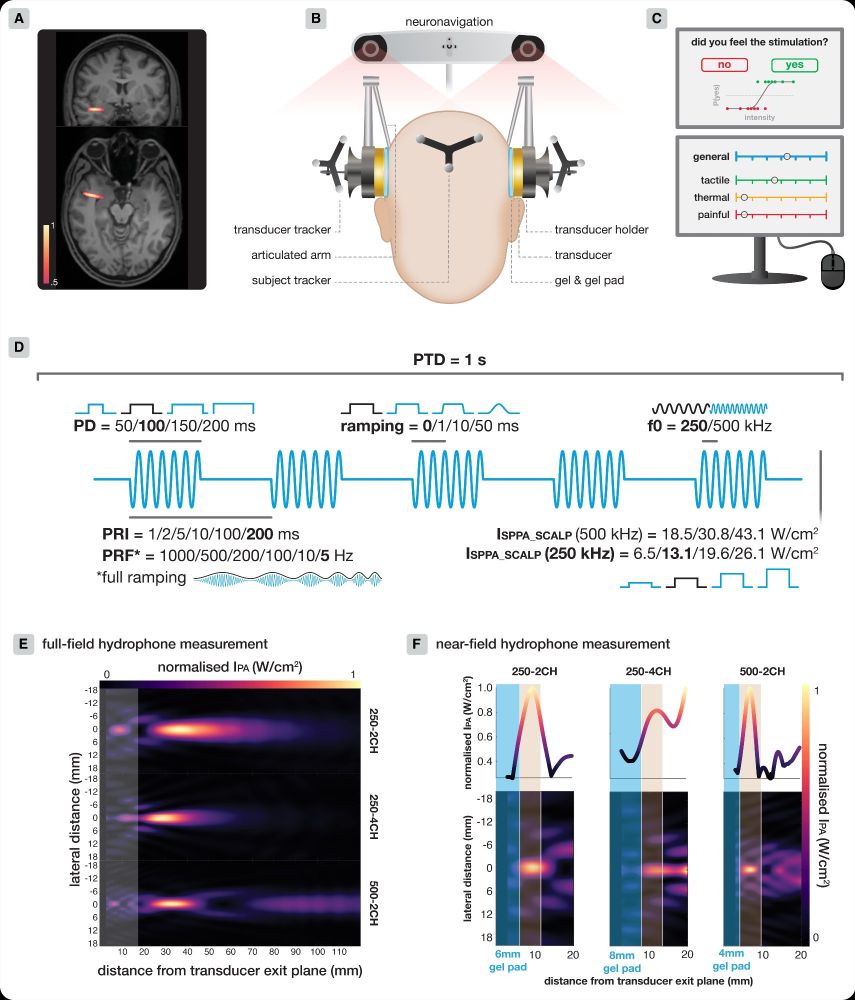
We applied TUS through the temples and measured participants' somatosensory experience at the stimulation site (VAS/threshold). We tested several stimulation protocols across three different transducers to identify avenues for confound mitigation.
19.06.2025 20:18 — 👍 0 🔁 0 💬 1 📌 0
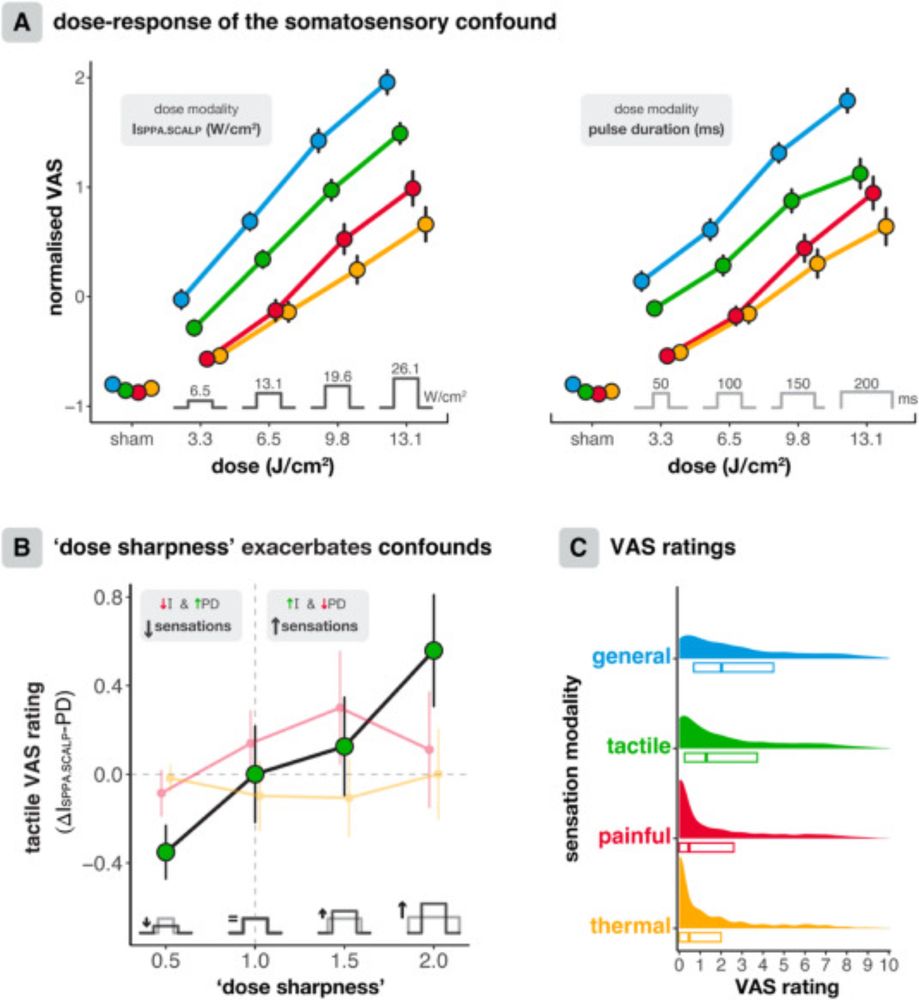
Parameter optimisation for mitigating somatosensory confounds during transcranial ultrasonic stimulation
Transcranial ultrasonic stimulation (TUS) redefines what is possible with non-invasive
neuromodulation by offering unparalleled spatial precision and flexible targeting
capabilities. However, peripher...
Hold on to your transducers, TUS community! We've focused on managing what participants can hear during stimulation… but how about what they feel?! Our BrainStim paper maps tactile, thermal, & painful sensations during transcranial ultrasonic stimulation - and reveals how to minimize them. Thread👇
19.06.2025 20:18 — 👍 6 🔁 1 💬 1 📌 0

Rapid modulation of choice behavior by ultrasound on the human frontal eye fields
A fundamental challenge in neuroscience is establishing causal brain-function relationships with spatial and temporal precision. Transcranial ultrasonic stimulation (TUS) offers a unique opportunity t...
👀 Look to your left! Look to your right! I just 'stimulated' your frontal eye fields (FEFs)! 🧠 In our latest study, we developed a temporally precise Transcranial Ultrasonic Stimulation (TUS) protocol to modulate the human FEFs & uncover new insights into brain function!👇
doi.org/10.1101/2025...
02.04.2025 16:24 — 👍 10 🔁 6 💬 1 📌 0
This work demonstrates that TUS can indeed be felt, provides a roadmap for managing participant burden, and supports proper experimental blinding to enhance the validity of TUS research. Thank you to my collaborators @lennartverhagen.bsky.social, Hanneke den Ouden, Kim Butts Pauly, & Linda de Jong!
20.03.2025 16:22 — 👍 0 🔁 0 💬 0 📌 0
Interestingly, our results also provide preliminary evidence that particle displacement is a primary biophysical driving force underlying somatosensory co-stimulation. In the future, we may be able to leverage such insights to maximise CNS neuromodulatory efficacy while minimizing confounds.
20.03.2025 16:22 — 👍 0 🔁 0 💬 1 📌 0

While considering influence on CNS neuromodulation (!!), we can:
- Eliminate near-field intensity peaks in the scalp
- Use larger aperture areas
- Apply ramping
- Deliver equivalent doses via longer, lower intensity pulses
- Apply higher PRFs (≥200 Hz)
- Apply higher f0 (e.g., 500 vs 250 kHz)
20.03.2025 16:22 — 👍 0 🔁 0 💬 1 📌 0
How can we reduce these somatosensory confounds without compromising neuromodulation in the brain by reducing dose? Our systematic parameter mapping reveals several possible strategies:
20.03.2025 16:22 — 👍 0 🔁 0 💬 1 📌 0
All participants in our study reported feeling something during TUS. Tactile sensations like 'buzzing' and 'prickling' emerged at lower doses, with thermal and painful sensations emerging as dose increased. This poses a real challenge for blinding.
20.03.2025 16:22 — 👍 0 🔁 0 💬 1 📌 0
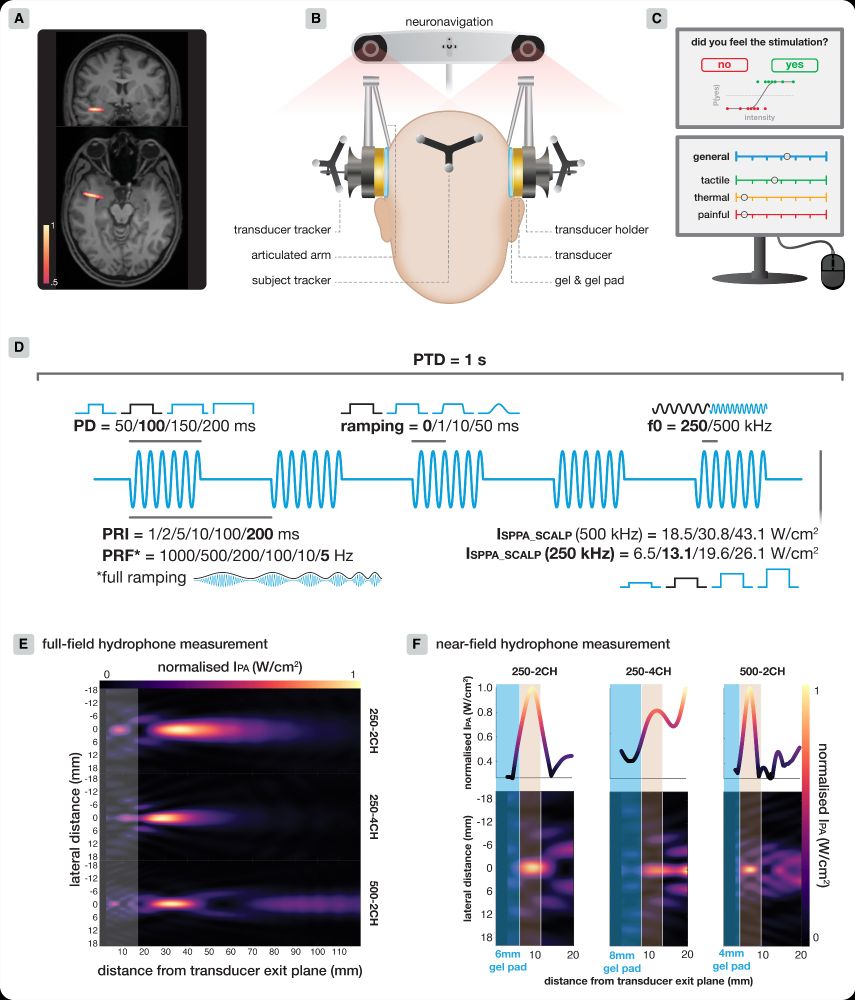
We applied TUS through the temples and measured participants' somatosensory experience at the stimulation site (VAS/threshold). We tested several stimulation protocols across three different transducers to identify avenues for confound mitigation.
20.03.2025 16:22 — 👍 0 🔁 0 💬 1 📌 0
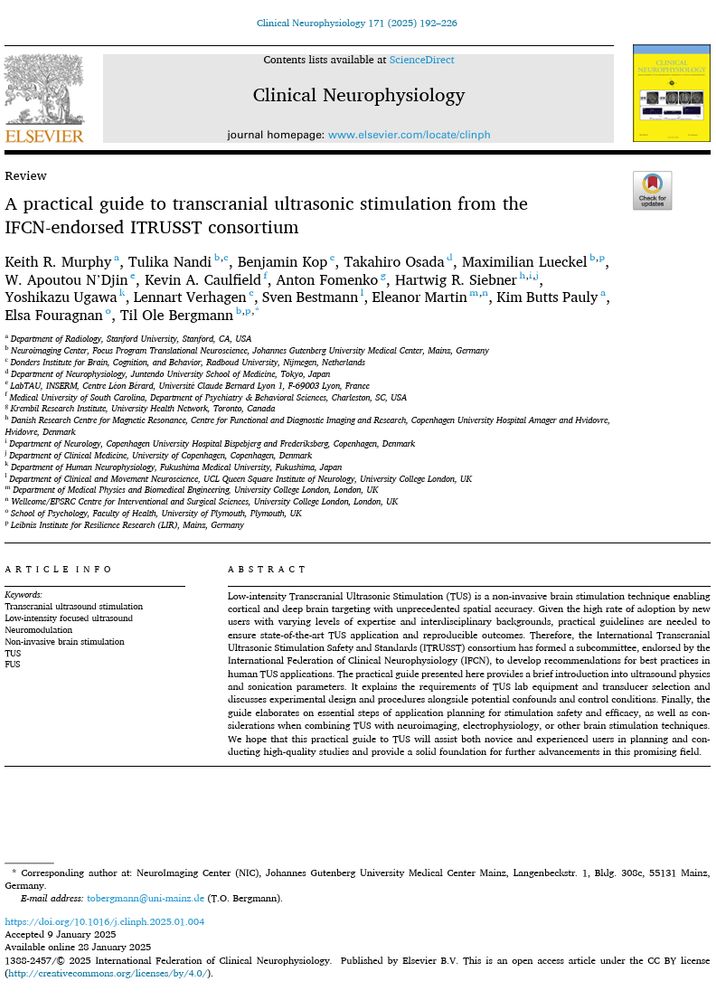
[Highlight of the Month] Murphy et al. A practical guide to transcranial ultrasonic stimulation from the IFCN-endorsed ITRUSST consortium. Clin Neurophysiol 2025;171:192-226. Open access: doi.org/10.1016/j.cl...
02.03.2025 13:09 — 👍 5 🔁 3 💬 0 📌 0
We speculate on why prior findings don’t replicate in our manuscript, but one thing is clear: double-blinding, TUS (& TMS) neuronavigation, and acoustic simulations are key to supporting the replicability required for TUS to truly make waves!
28.11.2024 14:21 — 👍 1 🔁 0 💬 0 📌 0
For those of you now concerned about using this protocol, don't worry! There are still multiple convincing studies using 5Hz-rTUS/tbTUS with promising results, so there's no need to abandon it. Instead, let's focus our efforts on reproducibility in this quickly expanding field!
28.11.2024 14:21 — 👍 0 🔁 0 💬 1 📌 0
This raises big questions:
How were such consistent excitatory effects found in prior work with variable hotspot-based targeting? Particularly considering that another independent study using 5Hz-rTUS with confirmed structural targeting reported opposite (inhibitory) effects! 🤔
28.11.2024 14:21 — 👍 0 🔁 0 💬 1 📌 0
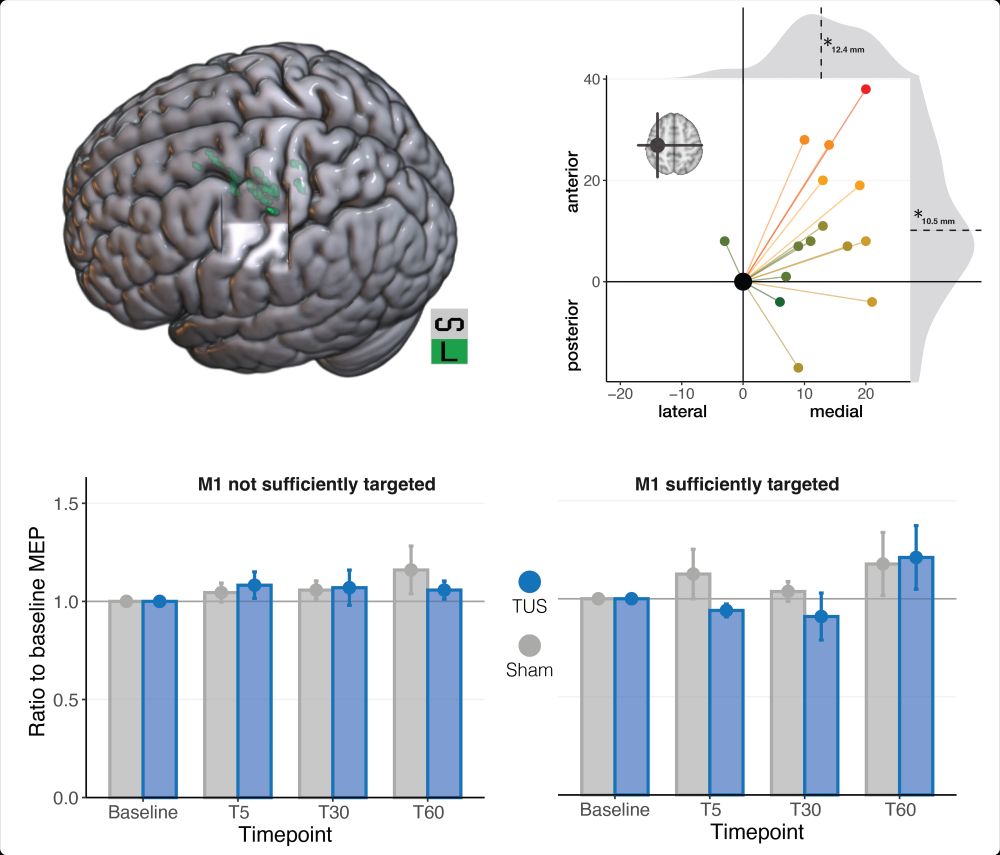
Importantly, when M1 was effectively targeted, we still didn't find evidence for offline excitatory effects!
28.11.2024 14:21 — 👍 0 🔁 0 💬 1 📌 0
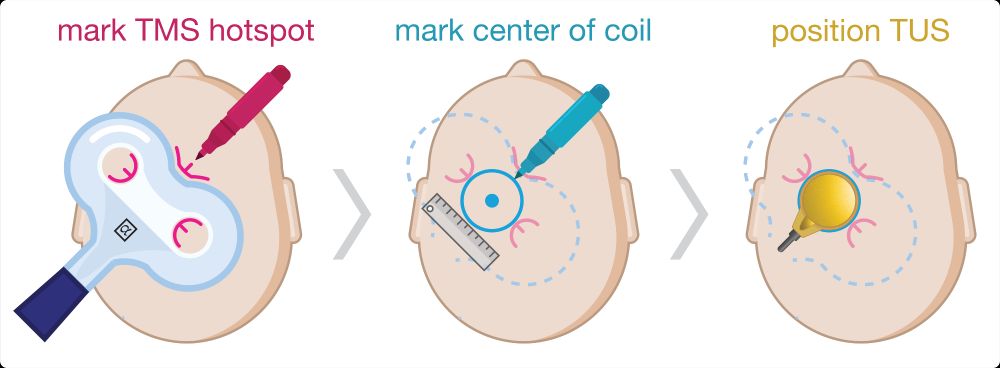
We replicated the same TMS hotspot-based targeting approach for TUS as prior work, but by introducing post-hoc simulations we showed that this method can lead to unacceptable M1 targeting variability as compared to structurally/functionally informed targeting.
28.11.2024 14:21 — 👍 0 🔁 0 💬 1 📌 0
The strong & prolonged excitatory effects of 5Hz-rTUS (tbTUS) reported several times by one research group didn't replicate over APB, FDI, or ADM muscles. TUS targeting might contribute to this variability, though it cannot explain such a large discrepancy in results.
28.11.2024 14:21 — 👍 0 🔁 0 💬 1 📌 0
In this pre-registered study, we precisely replicated prior methodology, but added some key improvements:
- double-blinding
- TMS neuronavigation
- post-hoc acoustic simulations
TMS and EMG were used to capture intracortical and corticospinal excitability (SICI, ICF, & MEP).
28.11.2024 14:21 — 👍 0 🔁 0 💬 1 📌 0
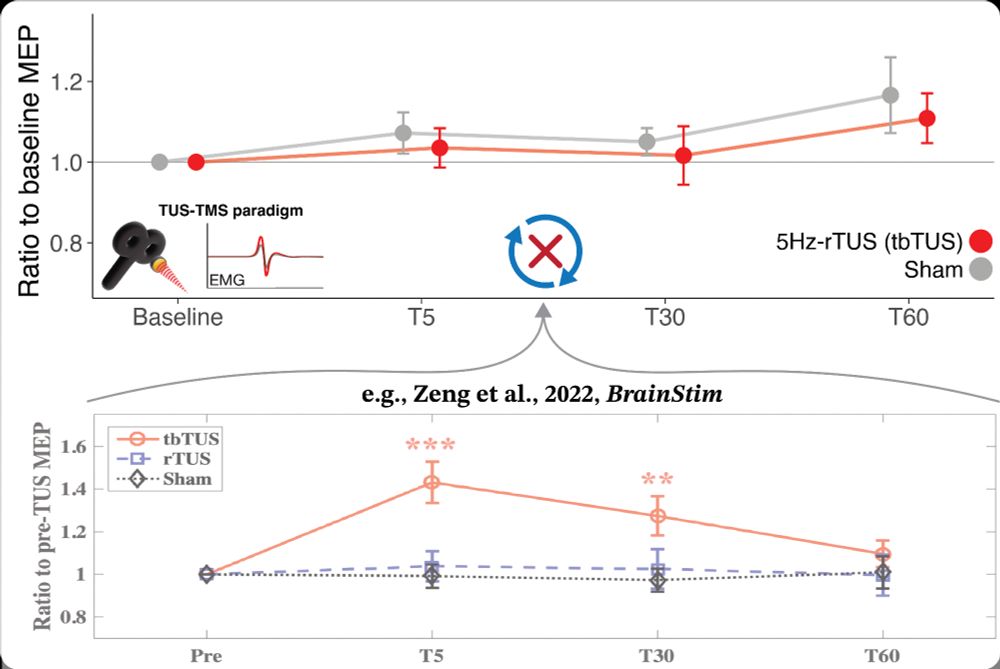
Effects of 5Hz-rTUS (tbTUS) on corticospinal excitability are less robust than we initially thought. Check out my new preprint with @drcarysevans.bsky.social and Po-Yu Fong showing that offline excitatory TUS-TMS effects don't replicate. Thread below 👇 doi.org/10.1101/2024...
28.11.2024 14:21 — 👍 7 🔁 4 💬 1 📌 0
I'm still missing lots of transcranial ultrasound neuromod folks on BlueSky, so trying to create a starter pack that I hope we can add many people to in the next weeks... please spread the word and let me know who I have missed out!
go.bsky.app/EjjWSUy
17.11.2024 18:08 — 👍 10 🔁 5 💬 2 📌 1
Moving forward, amplitude modulation (ramping), improved auditory masking, and carefully constructed (active) control conditions will form the strong foundation required for TUS to realize its full potential 🚀
21.11.2024 11:14 — 👍 0 🔁 0 💬 0 📌 0
A central challenge is identifying effective and robust TUS protocols. The TUS-TMS paradigm is a common testbed in humans that has popularized the 1000 Hz and 5 Hz protocols. Such studies need proper controls to make substantiated inferences that can guide future work.
21.11.2024 11:14 — 👍 0 🔁 0 💬 1 📌 0
We applied TUS at 6.35-65 W/cm^2 free-water Isppa, at multiple pulse train durations, both with and without auditory masking. We controlled for the auditory confound through matched sound-sham and novel (in)active control conditions.
21.11.2024 11:14 — 👍 0 🔁 0 💬 1 📌 0

In this multi-center collaboration (N=67), we show that seminal online motor inhibitory effects of 1000Hz TUS are caused by indirect auditory stimulation, not direct ultrasonic neuromodulation. Even seemingly dose-dependent effects can be driven by confounds.
21.11.2024 11:14 — 👍 0 🔁 0 💬 1 📌 0
Neuromodulator. TMS-fMRI has an extra special place in my heart.
Currently a Stanford Visiting Scholar in focused ultrasound and precision neurostimulation.
Newly minted PhD in Neuroscience @ Newcastle University, UK.
Looking into all things memory across species.
PhD candidate at tobergmann neurostimulation lab, JGU Mainz | interested in brain stimulation (TMS), memory & sleep research, and science reproducibility
Postdoc in visual cognitive neuroscience - Donders Institute, Radboud University -
https://sites.google.com/view/marcogandolfo/publications
Postdoctoral researcher at the Universitätsklinikum Hamburg-Eppendorf (UKE), Institute of Systems Neuroscience. I am interested in the neurobiological mechanisms of learning and decision-making under threat.
🎸🎮🐱
he/him
Individual differences in learning and decision-making in relation to mental health and resilience in daily life. Postdoc @Donders Institute, Radboud University, Nijmegen NL / Asst Prof @Institute of Psychology, ELTE, Eötvös Loránd University, Budapest HU
Neuroscientist | Professor of Medical Psychology at U Bonn | PI Neuroscience of Motivation, Action, & Desire Lab at U Bonn & Tübingen
aka @cornu_copiae
Enabling the very best neuroscience research with tailored non-invasive brain stimulation & brain imaging solutions. #TMS #tES #TUS #TMS_EEG #fMRI #fNIRS #OPM-MEG #NIBS
https://brainbox-neuro.com
Lecturer AI Radboud University | entrepreneur | advice & consultancy
Cognitive Neuroscientist
PostDoc @ Donders Institute
Physicist, Inserm professor interested in Physics, Waves, Neuroscience, Ultrasound, Physiology and Biomedical Technologies
@physmedparis.bsky.social
Co-Founder Supersonic Imagine, CardiaWave, Iconeus, eMyoSound and Sonomind
Deconstructing brain stimulation tools to build personalized treatments for mental health disorders.
precisionneuro.stanford.edu
Assist. prof. at Uni of Groningen in cognitive neuroscience and non-invasive brain stimulation. ⚡🧲 | #scicomm on the YouTube: Psyched! | 🌱
https://www.mileswischnewski.com/
https://www.youtube.com/@real.psyched
All things neurotech 🧠 | Postdoc in transcranial ultrasound stimulation 🔊 University of Oxford | jaketoth.tech












